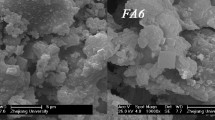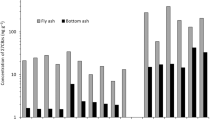Abstract
Hexachlorobutadiene (HCBD) was listed as a new controlling persistent organic pollutant in the Stockholm Convention because of its wide industrial applications and potential genotoxicity and carcinogenicity. However, only limited information exists on the release of HCBD from unintentional sources, such as waste incineration. Identification and quantification of HCBD in fly ash, one of the major outputs of waste incineration, is imperative. This work presents a simple method for determining HCBD in waste incineration fly ash based on ultrasonic extraction coupled with a silica gel–Florisil column cleanup followed by gas chromatography–mass spectrometry detection. Two typical persistent organic pollutants, pentachlorobenzene (PeCB) and hexachlorobenzene (HCB), were measured simultaneously. The parameters that influence the extraction efficiency and the quality of instrument detection were studied. Under the optimum experimental conditions, high sensitivity (detection limit 0.25–0.53 ng g-1), acceptable recoveries (64.0–71.4%) at spiking levels of 5–500 ng g-1, and good repeatability [relative standard deviation (n = 3) of 14% or less] were achieved for all target analytes. The validation of this method was performed by analysis of six real fly ash samples from different waste incinerators in eastern China. The concentrations of HCBD detected in these samples (1.39–97.6 ng g-1) were comparable to those of PeCB (1.22–150 ng g-1) and HCB (0.82–120 ng g-1), indicating that the residual HCBD as well as PeCB and HCB in waste incineration fly ash should not be ignored. The results confirm for the first time that waste incineration is an unintentional source of HCBD in China.

An analytical method for hexachlorobutadiene, pentachlorobenzene, and hexachlorobenzene in fly ash from waste incineration. GC-MS gas chromatography–mass spectrometry, Ph-d10 phenanthrene-d10



Similar content being viewed by others
References
Persistent Organic Pollutants Review Committee. POPRC-7/3: Hexachlorobutadiene. 2011. Available from http://chm.pops.int/Convention/POPsReviewCommittee/POPRCMeetings/POPRC7/POPRC7ReportandDecisions/tabid/2472/Default.aspx. Accessed 28 Jun 2017.
Persistent Organic Pollutants Review Committee. UNEP/POPS/POPRC.8/16/Add.2: Risk profile on hexachlorobutadiene. 2012. Available from http://chm.pops.int/Convention/POPsReviewCommittee/LatestMeeting/POPRC8/POPRC8ReportandDecisions/tabid/2950/Default.aspx. Accessed 28 Jun 2017.
Persistent Organic Pollutants Review Committee. POPRC-9/2: Hexachlorobutadiene. 2013. Available from http://chm.pops.int/Convention/POPsReviewCommittee/LatestMeeting/POPRC9/POPRC9Documents/tabid/3281/Default.aspx. Accessed 28 Jun 2017.
Conference of the Parties to the Stockholm Convention. SC-7/12: Listing of hexachlorobutadiene 2015 Available form http://chm.pops.int/TheConvention/ConferenceoftheParties/Meetings/COP7/tabid/4251/mctl/ViewDetails/EventModID/870/EventID/543/xmid/13075/Default.aspx. Accessed 28 Jun 2017.
Eighth Meeting of the Conference of the Parties to the Stockholm Convention. 2017. http://chm.pops.int/TheConvention/ConferenceoftheParties/Meetings/COP8/tabid/5309/Default.aspx. Accessed 28 Jun 2017.
World Wildlife Fund US. Stockholm Convention; “New POPs”. Screening additional POPs candidates. 2005. http://assets.panda.org/downloads/newpopsfinal.pdf. Accessed 28 Jun 2017.
Lecloux A. Hexachlorobutadiene - sources, environmental fate and risk characterisation. 2004. http://www.eurochlor.org/media/14939/sd5-hexachlorobutadiene-final.pdf. Accessed 28 Jun 2017.
Lenoir D, Wehrmeier A, Sidhu SS, Taylor PH. Formation and inhibition of chloroaromatic micropollutants formed in incineration processes. Chemosphere. 2001;43:107–14.
Environment Canada & Health Canada. Canadian Environmental Protection Act 1999: priority substances list assessment report on hexachlorobutadiene. 2000. https://www.canada.ca/content/dam/hc-sc/migration/hc-sc/ewh-semt/alt_formats/hecs-sesc/pdf/pubs/contaminants/psl2-lsp2/hexachlorobutadiene/hexachlorobutadiene-eng.pdf. Accessed 28 Jun 2017.
Expert Team to Support Waste Implementation. Study on waste related issues of newly listed POPs and candidate POPs. 2011. http://ec.europa.eu/environment/waste/studies/pdf/POP_Waste_2011.pdf. Accessed 28 Jun 2017.
Tian H, Gao J, Lu L, Zhao D, Cheng K, Qiu P. Temporal trends and spatial variation characteristics of hazardous air pollutant emission inventory from municipal solid waste incineration in China. Environ Sci Technol. 2012;46:10364–71.
Mazzanti M, Zoboli R. Waste generation, waste disposal and policy effectiveness evidence on decoupling from the European Union. Resour Conserv Recycl. 2008;52:1221–34.
Chen HW, Chang NB, Chen JC, Tsai SJ. Environmental performance evaluation of large-scale municipal solid waste incinerators using data envelopment analysis. Waste Manage. 2010;30:1371–81.
Chang FY, Wey MY. Comparison of the characteristics of bottom and fly ashes generated from various incineration processes. J Hazard Mater. 2006;138:594–603.
Ariese F, Swart K, Morabito R, Brunori C, Balzamo S, Slobodnik J, et al. Leaching studies of inorganic and organic compounds from fly ash. Int J Environ Anal Chem. 2002;82:751–70.
Pan Y, Yang L, Zhou J, Liu J, Qian G, Ohtsuka N, et al. Characteristics of dioxins content in fly ash from municipal solid waste incinerators in China. Chemosphere. 2013;92:765–71.
Juang DF, Lee CH, Chen WC, Yuan CS. Do the VOCs that evaporate from a heavily polluted river threaten the health of riparian residents? Sci Total Environ. 2010;408:4524–31.
Barrek S, Cren-Olivé C, Wiest L, Baudot R, Arnaudguilhem C, Grenier-Loustalot MF. Multi-residue analysis and ultra-trace quantification of 36 priority substances from the European Water Framework Directive by GC–MS and LC-FLD-MS/MS in surface waters. Talanta. 2009;79:712–22.
Tang Z, Huang Q, Cheng J, Qu D, Yang Y, Guo W. Distribution and accumulation of hexachlorobutadiene in soils and terrestrial organisms from an agricultural area, east China. Ecotox Environ Safe. 2014;108:329–34.
Lee CL, Song HJ, Fang MD. Concentrations of chlorobenzenes, hexachlorobutadiene and heavy metals in surficial sediments of Kaohsiung coast, Taiwan. Chemosphere. 2000;41:889–99.
Lee CL, Song HJ, Fang MD. Pollution topography of chlorobenzenes and hexachlorobutadiene in sediments along the Kaohsiung coast, Taiwan - a comparison of two consecutive years’ survey with statistical interpretation. Chemosphere. 2005;58:1503–16.
Lava R, Majoros LI, Dosis I, Ricci M. A practical example of the challenges of biota monitoring under the Water Framework Directive. Trends Anal Chem. 2014;59:103–11.
Jürgens MD, Johnson AC, Jones KC, Hughes D, Lawlor AJ. The presence of EU priority substances mercury, hexachlorobenzene, hexachlorobutadiene and PBDEs in wild fish from four English rivers. Sci Total Environ. 2013;461–462:441–52.
Majoros LI, Lava R, Ricci M, Binici B, Sandor F, Held A, et al. Full method validation for the determination of hexachlorobenzene and hexachlorobutadiene in fish tissue by GC–IDMS. Talanta. 2013;116:251–8.
Macgregor K, Oliver IW, Harris L, Ridgway IM. Persistent organic pollutants (PCB, DDT, HCH, HCB & BDE) in eels (Anguilla anguilla) in Scotland: current levels and temporal trends. Environ Pollut. 2010;158:2402–11.
Zhang H, Wang Y, Sun C, Yu M, Gao Y, Wang T, et al. Levels and distributions of hexachlorobutadiene and three chlorobenzenes in biosolids from wastewater treatment plants and in soils within and surrounding a chemical plant in China. Environ Sci Technol. 2014;48:1525–31.
Surma-Zadora M, Grochowalski A. Using a membrane technique (SPM) for high fat food sample preparation in the determination of chlorinated persistent organic pollutants by a GC/ECD method. Food Chem. 2008;111:230–5.
Liu G, Jiang X, Wang M, Dong S, Zheng M. Comparison of PCDD/F levels and profiles in fly ash samples from multiple industrial thermal sources. Chemosphere. 2015;133:68–74.
Wang M, Liu G, Jiang X, Zheng M, Yang LL, Zhao Y, et al. Thermochemical formation of polybrominated dibenzo-p-dioxins and dibenzofurans mediated by secondary copper smelter fly ash, and implications for emission reduction. Environ Sci Technol. 2016;50:7470–9.
Liu G, Zhan J, Zhao Y, Li L, Jiang X, Fu J, et al. Distributions, profiles and formation mechanisms of polychlorinated naphthalenes in cement kilns co-processing municipal waste incinerator fly ash. Chemosphere. 2016;155:348–57.
Hue NT, Thuy NTT, Tung NH. Polychlorobenzenes and polychlorinated biphenyls in ash and soil from several industrial areas in north Vietnam: residue concentrations, profiles and risk assessment. Environ Geochem Health. 2016;38:399–411.
Liu G, Liu W, Cai Z, Zheng M. Concentrations, profiles, and emission factors of unintentionally produced persistent organic pollutants in fly ash from coking processes. J Hazard Mater. 2013;261:421–6.
Hung PC, Chen QH, Chang MB. Pyrolysis of MWI fly ash - effect on dioxin-like congeners. Chemosphere. 2013;92:857–63.
Lin YS, Chen KS, Lin YC, Hung CH, Chang-Chien GP. Polychlorinated dibenzo-p-dioxins/dibenzofurans distributions in ash from different units in a municipal solid waste incinerator. J Hazard Mater. 2008;154:954–62.
Richter BE, Jones BA, Ezzell JL, Porter NL, Avdalovic N, Pohl C. Accelerated solvent extraction: a technique for sample preparation. Anal Chem. 1996;68:1033–9.
Richter BE, Ezzell JL, Knowles DE, Hoefler F, Mattulat AKR, Scheutwinkel M, et al. Extraction of polychlorinated dibenzo-p-dioxins and polychlorinated dibenzofurans from environmental samples using accelerated solvent extraction (ASE). Chemosphere. 1997;34:975–87.
Masala S, Bergvall C, Westerholm R. Determination of benzo[a]pyrene and dibenzopyrenes in a Chinese coal fly ash certified reference material. Sci Total Environ. 2012;432:97–102.
Preud'homme H, Potin-Gautier M. Optimization of accelerated solvent extraction for polyhalogenated dibenzo-p-dioxins and benzo-p-furans in mineral and environmental matrixes using experimental designs. Anal Chem. 2003;75:6109–18.
Tadeo JL, Sánchez-Brunete C, Albero B, García-Valcárcel AI. Application of ultrasound-assisted extraction to the determination of contaminants in food and soil samples. J Chromatogr A. 2010;1217:2415–40.
Gago-Ferrero P, Borova V, Dasenaki ME, Thomaidis NS. Simultaneous determination of 148 pharmaceuticals and illicit drugs in sewage sludge based on ultrasound-assisted extraction and liquid chromatography-tandem mass spectrometry. Anal Bioanal Chem. 2015;407:4287–97.
Li Y, Yang Y, Yu G, Huang J, Wang B, Deng S, et al. Emission of unintentionally produced persistent organic pollutants (UPOPs) from municipal waste incinerators in China. Chemosphere. 2016;158:17–23.
Kim NH, Lee JS, Park KA, Kim YH, Lee SR, Lee JM, et al. Determination of matrix effects occurred during the analysis of organochlorine pesticides in agricultural products using GC-ECD. Food Sci Biotechnol. 2016;25:33–40.
Acknowledgements
The authors acknowledge funding for this study provided by the National Natural Science Foundation of China (21507113, 21477117, and 21607130), the Natural Science Foundation of Zhejiang Province (LY15B070006, and LR14E080001), the Program for Changjiang Scholars and Innovative Research Team in University (IRT13096), and the State Key Laboratory of Environmental Chemistry and Ecotoxicology, Research Center for Eco-Environmental Sciences, Chinese Academy of Sciences (KF2014-17).
Author information
Authors and Affiliations
Corresponding authors
Ethics declarations
Conflict of interest
The authors declare that they have no competing interests.
Electronic supplementary material
ESM 1
(PDF 489 kb)
Rights and permissions
About this article
Cite this article
Zhang, H., Jiang, L., Zhou, X. et al. Determination of hexachlorobutadiene, pentachlorobenzene, and hexachlorobenzene in waste incineration fly ash using ultrasonic extraction followed by column cleanup and GC-MS analysis. Anal Bioanal Chem 410, 1893–1902 (2018). https://doi.org/10.1007/s00216-018-0849-5
Received:
Revised:
Accepted:
Published:
Issue Date:
DOI: https://doi.org/10.1007/s00216-018-0849-5




